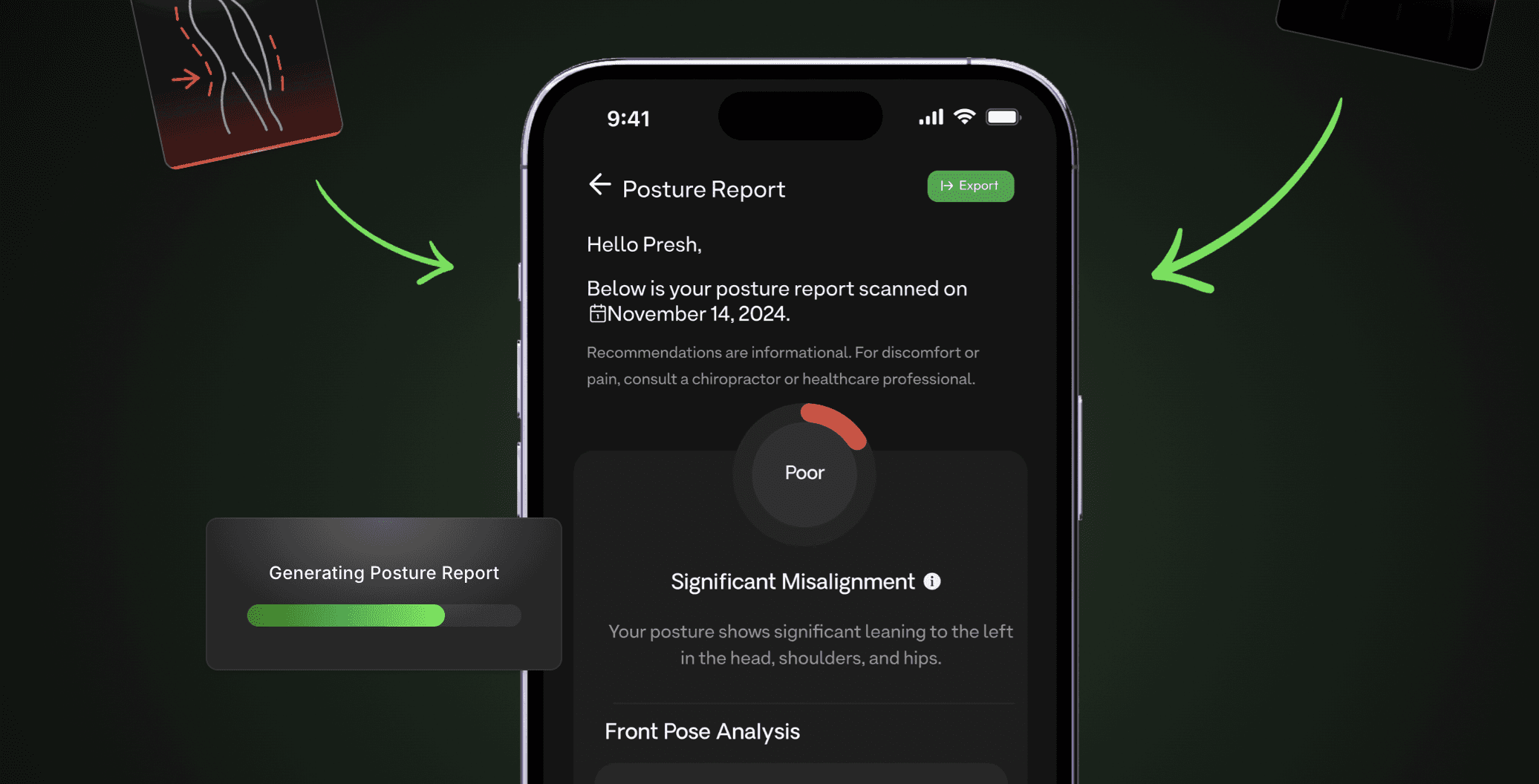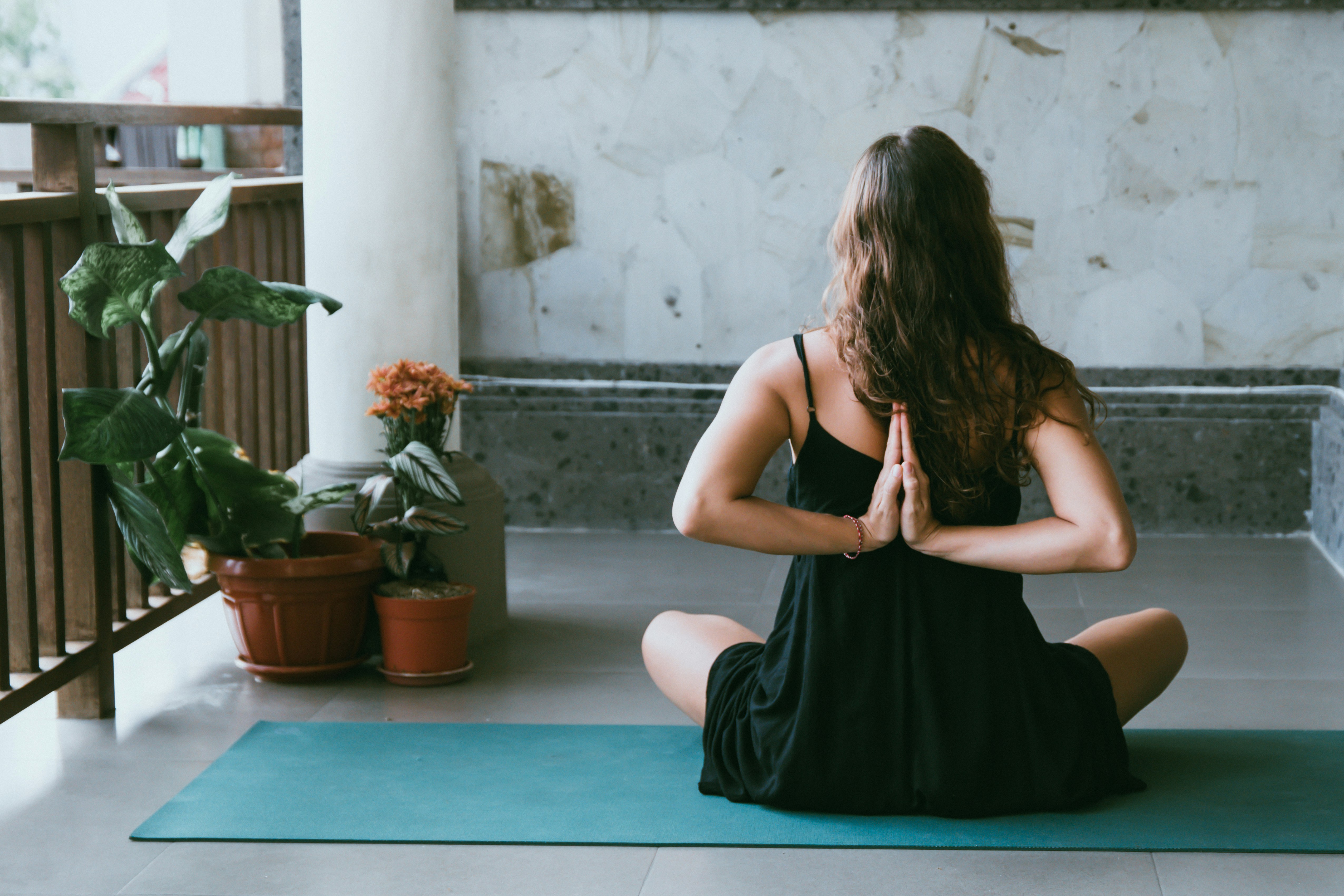17 Best Exercises for Kyphotic Posture to Restore Balance
Mar 22, 2025
Do you often find yourself slouching on the couch or hunching over your phone? You're not alone, modern life promotes an abnormal posture known as kyphosis or excessive upper back rounding. This slouched position can form over time, leading to stiffness and discomfort in your upper back, neck, and shoulders. Fortunately, targeted wall posture exercises for kyphotic posture can help strengthen and stretch the muscles affecting your posture so you can stand taller, move more freely, and reduce your risk of further injury.
Posture AI’s posture correction app offers a valuable solution to help you achieve your goals, such as correcting kyphotic posture, standing taller, moving pain-free, and feeling more aligned and balanced. This innovative tool uses artificial intelligence to analyze your posture and create a personalized program of corrective exercises to help you achieve your objectives.
Table of Content
What are the Key Symptoms of Kyphotic Posture?

Kyphotic posture, also known as hunchback or round back, refers to an exaggerated curvature of the upper spine leading to a rounded appearance of the upper back. Postural kyphosis is the most common type, often due to poor posture, muscle weakness, or imbalances.
This type of kyphosis is usually flexible and can be corrected with:
Proper posture
Exercises
Chiropractic care
Maintaining good posture and incorporating exercises to strengthen the back muscles can help prevent and improve kyphotic posture. It is essential to be mindful of your posture daily to reduce strain on the spine.
What Causes Kyphosis?
Kyphosis can develop due to various factors, from postural habits to underlying medical conditions. Understanding the causes of kyphosis can help prevent, diagnose, and treat the condition effectively. Some of the leading causes of kyphosis include:
Degenerative changes in the spine
As we age, the spinal discs, which act as cushions between the vertebrae, can degenerate and lose their elasticity. This can lead to a loss of disc height and a more pronounced upper back curvature. Age-related conditions such as osteoporosis and arthritis can weaken the spinal bones and joints and contribute to the development of kyphosis.
Compression Fractures
Compression fractures of the vertebrae can occur due to trauma, osteoporosis, or other conditions that weaken the spinal bones. A vertebra fracture or collapse can cause a sudden and abnormal spine curvature, leading to kyphosis.
Muscular Weakness
Weak core and back muscles can contribute to the development of postural kyphosis. When the muscles responsible for supporting the spine and maintaining proper posture are not strong enough, the upper back may gradually curve forward, resulting in a hunched appearance.
Altered Biomechanics or Movement Patterns
Poor posture, sedentary lifestyle, and repetitive motions can alter the biomechanics of the spine and contribute to the development of kyphosis. For example, prolonged periods of sitting with a rounded back or frequently bending forward can place excessive stress on the spinal structures and lead to muscle imbalances and postural changes.
What Are the Symptoms of Kyphotic Posture?
Rounded shoulders, where the upper back appears hunched forward, are a common symptom of kyphotic posture. Due to the increased curvature of the spine in kyphotic posture, back pain and stiffness in the upper back area can be experienced. Difficulty maintaining proper posture while sitting or standing may occur due to kyphotic posture, leading to slouching.
Kyphosis and Musculoskeletal Strain
Due to the added stress on the upper back and neck muscles, individuals with kyphotic posture might feel fatigued and experience muscle strain. Limited range of motion in the upper back and shoulders can also be a symptom of kyphotic posture, making it challenging to perform specific movements comfortably.
A certain amount of kyphosis, or spinal curvature, is essential to keep your spine healthy. Nevertheless, stretching and strengthening the muscles of your spine will help maintain a healthy amount of the curve while making it easier to maintain an upright posture.
How Can You Correct Kyphotic Posture?
Horizontal Posture Check
This exercise helps you find a natural position without excessive upper back curvature.
Lie flat on the ground with your legs stretched out. Place your hands on your stomach, just below your ribs. Let your shoulders relax towards the ground.
Slowly slide your heels towards your body, bending your knees. Place your hands flat on the ground at your sides. Pay attention to your back. You should feel your entire back in contact with the ground, to the top of your shoulders. You may feel a gentle stretch in your back if you have been experiencing kyphosis for a while.
This position involves a natural, relaxed curve of the spine instead of an extreme curve. Repeat this exercise to remind yourself of how healthy posture feels.
Related Reading
• How to Fix Rib Pain from Bad Posture
• How Long Does It Take for a Chiropractor to Fix Your Posture
17 Best Exercises for Kyphotic Posture to Restore Balance

1. Arm Raises: Strengthen & Stretch Shoulder Muscles
This stretch helps engage the muscles of your shoulders to strengthen and stretch them.
Stand with your arms at your sides and your palms facing forward.
Raise your arms and bend them at the elbows so your upper arms are parallel to the ground and your palms face forward, imitating a goalpost. Hold this position for five to ten seconds.
Raise your arms fully extended upward, as high as you can reach, palms facing forward. Hold this position for five to ten seconds, then lower your arms.
Repeat this exercise ten times per set, up to three times daily.
2. Shoulder Blade Squeeze: Strengthen Upper Back Muscles
This exercise helps you reduce tension and strengthen the muscles of your upper back:
Sit or stand upright and your shoulders pulled back.
Squeeze your shoulder blades together as tightly as possible, hold for five to ten seconds, release, and repeat.
Repeat this exercise three to five times per set and complete two sets daily.
3. Resistance Band Stretch: Add Resistance for Better Results
You can use a resistance band if you want to add extra resistance to shoulder blade exercises. Grasping each end of the resistance band in front of your body, stretch the band as far as you comfortably can with your arms parallel to the floor. Focus on using your shoulders, especially shoulder blades, for the stretch.
Hold the stretch for five to ten seconds, then slowly release. You can repeat this exercise three to five times per set and do up to three sets daily.
4. Mirror Image: Correct Poor Posture
For this exercise, simply do the opposite movement of the posture you’re trying to correct. Stand tall, against a wall if needed.
Tuck your chin slightly and bring your head back directly over your shoulders.
Bring shoulder blades back and down.
Hold for 30 seconds to 1 minute. Take a break if you begin to feel pain. Suppose it’s challenging to get your head to touch the wall while maintaining a chin tuck position; put a pillow behind you and press your head into it.
5. Head Retraction: Strengthen Neck Muscles
This exercise involves lying on the floor and is excellent for the neck muscles, which are often stretched out and weak.
Pull the chin back toward the floor as if trying to make a double chin.
Hold for 15 seconds. Repeat 5 to 10 times.
6. Superman: Strengthen Lower Back Muscles
Lying on your stomach, extend your hands in front of your head. Keep your head neutral and look toward the floor. Lift both arms and legs toward the ceiling. Feel as if your hands and feet are reaching far away from your body. Hold for 3 seconds and repeat 10 times.
7. Life Extension: Stretch Chest Muscles
This exercise aims to stretch the tight muscles of the chest and strengthen the weak muscles of the back.
Stand tall, knees soft, core engaged, chest upright, and shoulder blades back and down.
Raise your arms into a Y position with thumbs pointed behind you.
Take 2 to 3 deep breaths, maintaining this posture on the exhale.
8. Thoracic Spine Foam Rolling: Release Tension in Back Muscles
Lie on the floor with a foam roller under you, across your mid-back. Gently roll up and down on the foam roller, massaging your back and thoracic spine muscles. You can also try this with your arms extended over your head in the life extension position described above. Do this for at least 30 seconds to 1 minute.
9. Lying Extension on Swiss Ball: Strengthen Back Muscles
Start by sitting on a Swiss ball and roll the ball under you so that your back is flat on the ball. The ball contours should follow the curve of your spine. Let your back extend over the ball as you relax your arms out to your side. Hold this position to create an extension to your mid and upper back.
To strengthen the exercise, move your arms above your head. Hold this position for thirty seconds, and repeat three times.
10. Sitting Extension: Mobilize Upper Back
Place your hands interlocked behind your neck to support it. Round your lower back slightly to focus the movement on the upper back, and slowly bend backward. Repeat for 20 reps.
11. Standing Rows: Strengthen Upper Back Muscles
According to the American Academy of Orthopaedic Surgeons, the standing row exercise effectively targets the middle and lower trapezius. These muscles help bring together (retract) and lower (depress) your shoulder blades, combating the development of kyphosis.
Postural Strengthening
Secure a resistance band around the back of a doorknob and close the door so it is firmly held. Holding one end of the band in each of your hands, stand a few steps away from the door so the band is taut. Simultaneously, pull each end backward as you bend your elbows and squeeze your shoulder blades together.
Execution and Repetitions
The motion should mimic the movement of rowing the oars of a boat. Hold the squeeze for a second or two before returning to the starting position, and be sure not to shrug your shoulders upward as you complete the motion. Complete three sets of eight repetitions of these rows up to three times each week.
12. Prone Ts: Strengthen Upper Back Muscles
As mentioned, the middle and lower trapezius are critical postural muscles. The American Academy of Orthopedic Surgeons found that the prone T exercise (also known as prone horizontal abduction) is an effective way to strengthen this area using only a bed and a hand weight.
Lie on your stomach with your arm hanging off the edge of a bed or table.
Bring your shoulder blade down and back without tensing your neck muscles.
Keeping your scapula set, raise your arm to the side until it is parallel to the floor and your palm faces straight downward.
Hold this position for a second before lowering back down again. Up to three times per week, perform three sets of eight repetitions on each side.
Tip: Begin by doing the exercise without any hand weights. When it becomes easy, increase the weight in 1- to 2-pound increments to make it more challenging.
13. Chin Tucks: Strengthen Neck Muscles
While chin tucks don't directly affect the middle (thoracic) spine, they target other neck muscles that tend to be weak in individuals with a humped-back posture. According to the Cleveland Clinic, this exercise helps strengthen these muscles (called the deep cervical flexors) and reverses the forward head posture that often accompanies a hunched back.
Focused Chin Retraction
Sit in a chair and face a mirror. Place a finger on your chin. Retract your neck and chin backward away from the finger without moving the finger. If you complete the motion correctly, it will look like you are giving yourself a double chin. Hold this position for a second or two before relaxing. Try to do three sets of 10 chin tucks each day.
Tip: Be sure not to shrug your shoulders upward toward your ears or lean your body backward as you complete this exercise.
14. Cobra Stretch: Stretch Front Body Muscles
How to do it:
Lie face down on the floor with your hands under your shoulders.
Press into your hands to lift your chest off the floor, keeping your elbows slightly bent.
Hold the position and breathe deeply.
Duration: Hold for 20-30 seconds and repeat 3 times.
15. Prone Y, T, and I Raises: Strengthen Upper Back Muscles
How to do it:
Face on the floor with your arms extended overhead in a “Y” position.
Lift your arms off the floor, squeezing your shoulder blades together.
Lower your arms back to the floor.
Repeat the movement with your arms in a “T” position (straight out to the sides) and an “I” position (straight down along your sides).
16. Wall Angels: Improve Shoulder Mobility
How to do it:
Stand with your back against a wall, feet a few inches away.
Press your lower back, upper back, and head against the wall.
Raise your arms to form a “W” shape, then extend them overhead to create a “Y” shape.
Return to the “W” shape.
Repetitions: 10-15 times.
17. Bridge Exercise: Strengthen Core and Glute Muscles
How to do it:
Lie on your back with your knees bent and feet flat on the floor.
Lift your hips towards the ceiling, squeezing your glutes and engaging your core.
Hold for a few seconds and then lower back down.
Repetitions:10-15 times.
Related Reading
• How to Fix Flat Back Posture
• How to Fix Foot Posture
• Can You Go to Physical Therapy for Bad Posture
Improve Your Posture with Our Posture Correction App

Posture AI's posture correction app transforms your posture and well-being using advanced AI technology and your smartphone camera. Our app provides personalized posture analysis, expert-guided exercises, and progress tracking to help you move and feel better. Simply take front and side photos, and our AI generates detailed reports with tailored improvement plans.
Features include:
Instant posture scanning
AI-powered analysis
Customized exercise programs
Progress monitoring
Addressing Discomfort and Enhancing Well-being
Whether looking to prevent long-term issues, reduce daily discomfort, or boost confidence, Posture AI offers an affordable, at-home solution for better alignment.
Skip expensive treatments and transform your posture today with just a few minutes of guided daily exercise.
Related Reading
• How to Fix Chest Pain from Bad Posture
• Foam Roller Posture Exercises

